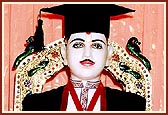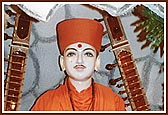|
|

Shri Harikrishna Maharaj, Sarangpur

Shri Ghanshyam Maharaj,
London
See More
Photos
|
This designation is given
to a period of one month from when the sun enters the Dhanur rashi (Sagitarius)
till the 14th of January.
s
The importance of this month is cited
by the Bharadwaj Samhita and the Panchratra shastra - in the Brahmhansa
dialogue. Great glory is attached to serving food to Brahmins and devotees
during this month. One story illustrating this is of a
king named Satyasangh who ruled a kingdom on the banks of the sacred
Narmada. Once while observing the vow of Dhanurmaas by serving food
to the Brahmins and devotees, he inadvertently committed a sin. This
karma resulted in him being bitten by a snake. However, the fruit of
his Dhanurmaas vow saved him. The parshads of Lord Vishnu took him to
Vaikunth.
Another story of serving food to a Brahmin is of Yudhisthir. Once by
Lord Krishna's command, Yudhisthir served food to a pure Brahmin, who
usually cooked his own food. After the meal, Yudhisthir lifted the leaf
dish. Underneath he discovered a second. Lifting this, there was a third.
In this manner he lifted 1000 leaf dishes! To the astonished Yudhisthir,
Lord Krishna revealed, "Yudhisthir, by serving a true Brahmin,
you have obtained the fruit of serving a thousand Brahmins."
The glory of this month has
also been extolled in the Purushottam Samhita of the Panchratra shastra.
In the period the sun shifts from the Dhanur rashi till Makar Sankranti,
the Samhita advocates bhakti by celebrating Adhyayan, Mokshada and Vun
Mahotsavs.
Adhyayan
Festival
The Lord's murti is offered pujan.
Then the four Vedas, and Vedangas are recited. Every morning during
Dhanurmaas, at around sunrise shiro of mung and sweets made from milk
are offered to the Lord. Since Adhyayan refers to study of scriptures,
they are arranged in the following directions: Rg-Veda in the east,
Atharva in the north, Yajur Veda in the south, Saam Veda in the west,
Ramayan-Mahabharat in the south-east, Stotras in the south-west, Dharma
Shastra in the north-west, poetic literature written in Prakrut in the
north-east.
The month of Magshar is considered
the morning period of the Devas and therefore sattvic. Therefore this
festival boosts the sattvic attributes of aspirants.
Mokshada
Festival Origin
Once as a baby, Lord Vishnu lay sleeping
on a banyan leaf. At that time Lord Brahma manifested from Vishnu's
navel and sang stotras and Vedic hymns. In this manner, overwhelmed
with pride, he forgot the Lord. At that moment two demons appeared from
Lord Vishnu's ears and attacked Brahma. Frightened, he fervently prayed
to Vishnu. The Lord stopped the demons and offered them to request a
boon. However, the demons tongue-in-cheek, requested the Lord to ask
for a boon instead! Vishnu laughed and said, "I had vanquished
you long ago, yet you confront me again."
This infuriated the demons
and so they attacked the Lord. The ensuing battle lasted one and a half
months. Finally, the Lord defeated the two, who then begged," Prabhu!
Deliver us to your dham (abode)."
On the sud Ekadashi of Dhanurmaas,
the Lord opened the northern door and delivered them to Vaikunth, transcending
Satyalok. This pleased the two, who requested for a boon, "Take
those who offer bhakti to you and observe Ekadashi in this month, to
your abode through the northern door." The Lord agreed. Henceforth,
a festival for Moksha is also celebrated on the Ekadashis in this month
hence the name Mokshadotsav.
Festival
Ritual
Every morning during Dhanurmaas the
Lord is bathed with nine water-pots. He is then offered pujan, garments,
mung shiro and milk sweets. The Vedas and other scriptures listed above
are recited in all 8 directions.
A divo of sarsav and sesame
seed oil is lighted. A small murti of the Lord is then placed in a palanquin
and devotionally taken on a procession circumambulating the mandir.
He is then brought into the mandap (hall) through the northern door
and placed on a seat. Pujan is offered using the 16 pujadravyas while
chanting stotras. He is then placed in the palanquin. And after two
circumambulations reinstalled in the mandir.
Vun
(Forest) Festival
There is also great glory of a Vun
Mahotsav - forest festival in this month. The Lord is taken in a palanquin
to a forest area. Here He is offered pujan with the 16 pujadravyas and
devotional kirtans are sung.
Through these 3 festivals,
Dhanurmaas provides an opportunity to offer extra devotion to the Lord.
Today, the 'Mokshadotsav' festival is celebrated by offering 'naivedya'
(food).
The Vedas and other scriptures
in the Adhyayan festival are today replaced by other books, texts, writing
material and other objects such as toys and musical instruments.
This period is considered
inauspicious (kamurta) for social activities. The rishis were aware
that throughout the year, man is engrossed in mundane activities and
therefore overcome by his 'swabhavas' - base instincts. Therefore they
enjoined one month in which he would withdraw from his mundane activities
to attain inner peace by engaging in devotional activities like: listening
to spiritual discourses, singing kirtans and service, for bliss.
The 'Satsangijivanam' (4.59.1,2)
elaborates how this festival should be celebrated.
It is also said that Lord
Krishna studied during this month. Vaishnav Sampradaya's scripture,
'Pushti Prakash Seva Pranaalika' elaborates the bhakti rituals during
this period. The Vaishnav pandits believe that, since the days are short
during this period, Lord Krishna had to take the cows to pasture early.
Therefore with this underlying sentiment, he is awakened earlier and
offered 'Rajbhog' so that he is not delayed in taking the cows. Additionally,
he is given a small bundle containing a variety of snacks. In Nathdwara
the Rajbhog arti is performed prior to sunrise. Excepting this, all
Vaishnav mandirs perform the Rajbhog before 7.30 a.m. In the Swaminarayan
Sampradaya every early morning it is a bhakti tradition for devotees
to flock to mandirs during Dhanurmaas to sing dhun between Mangala and
Shrungar artis. Many also bring freshly made sweets to offer to the
Lord which is then distributed to the devotees as prasad.
|
|



